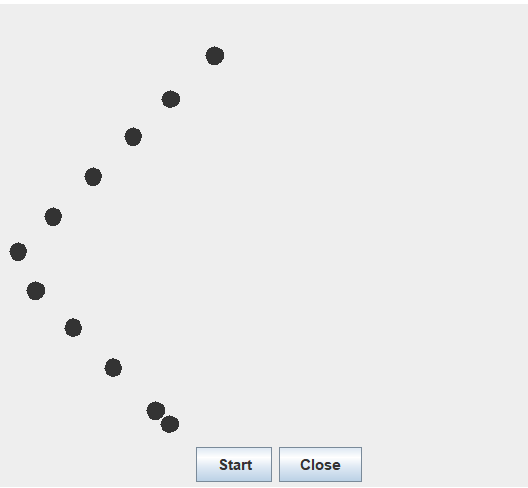201871010105-曹玉中《面向对象程序设计(java)》第十六周学习总结
| 项目 | 内容 |
| 这个作业属于哪个过程 | https://www.cnblogs.com/nwnu-daizh/ |
| 这个作业的要求在哪里 | https://www.cnblogs.com/zyja/p/11963340.html |
| 作业学习目标 |
(1) 掌握Java应用程序的打包操作; (2) 掌握线程概念; (3) 掌握线程创建的两种技术。 |
第一部分:理论知识。
进程:指一个内存中运行的应用程序。例如运行QQ那么它就是一个进程,而且一个应用程序可以同时运行多个进程
线程:线程是进程中的一个执行单元,就比如用360我们可以让它一边杀毒一边清理垃圾,那么360它就是一个进程,那么杀毒和清理垃圾就是进程下的两个线程
注:一个程序运行后至少有一个进程,一个进程中可以包含多个线程
Thread类
构造方法:
public Thread() :分配一个新的线程对象。
public Thread(String name) :分配一个指定名字的新的线程对象。
public Thread(Runnable target) :分配一个带有指定目标新的线程对象。
public Thread(Runnable target,String name) :分配一个带有指定目标新的线程对象并指定名字。
常用方法:
public String getName() :获取当前线程名称。
public void start() :导致此线程开始执行; Java虚拟机调用此线程的run方法。
public void run() :此线程要执行的任务在此处定义代码。
public static void sleep(long millis) :使当前正在执行的线程以指定的毫秒数暂停
public static Thread currentThread() :返回对当前正在执行的线程对象的引用。
创建线程的方式总共有两种:
1.是继承Thread类方式
2.是实现Runnable接口
创建线程的方式一:
定义Thread类子类,并重写该类的run()方法,run()方法的方法体就代表了线程需要完成的任务,
创建Thread子类的实例3. 调用Thread的start()方法来启动该线程
代码如下:
public class Test {
public static void main(String[] args) {
MyThread mt = new MyThread();
Thread t1 = new Thread(mt);
t1.start();
}
}
class MyThread extends Thread{
@Override
public void run(){
System.out.println("第一种方式创建线程");
}
}
创建线程的方式二:
定义Runnable接口的实现类,并重写该接口的run()方法,run()方法的方法体代表线程完成的任务
创建Runnable实现类的实例。
调用Thread的start()方法来启动线程。
代码如下:
public class Test {
public static void main(String[] args) {
MyRunnable mr = new MyRunnable();
Thread t1 = new Thread(mr);
t1.start();
}
}
class MyRunnable implements Runnable{
@Override
public void run(){
System.out.println("第二种方式创建线程");
}
}
Thread和Runnable的区别
因为类都是单继承的,如果一个类继承Thread,就不可以继承其他类了。但是如果实现了Runnable接口的话,则很容易的实现资源共享,避免了java中的单继承的局限性,所以Runnable比Thread更有优势
用匿名内部类创建线程
使用匿名内部类的方式实现Runnable接口,重写Runnable接口中的run方法:
代码如下:
public class Test {
public static void main(String[] args) {
new Thread(new Runnable(){
@Override
public void run() {
System.out.println("匿名内部类创建线程");
}
}).start();
}
}
线程安全问题的概述
如果有多个线程在同时运行,而这些线程可能会同时运行这段代码。程序每次运行结果和单线程运行的结果是一样的,而且其他的变量的值也和预期的是一样的,就是线程安全的。
那么什么是线程不安全的呢?我们由一段代码看一下:
这里我想打印的是1-100之间的整数:
public class Test {
public static void main(String[] args) {
MyRunnable r = new MyRunnable();
Thread t1 = new Thread(r);
Thread t2 = new Thread(r);
Thread t3 = new Thread(r);
t1.start();
t2.start();
t3.start();
}
}
class MyRunnable implements Runnable{
private int sum = 100;
public void run(){
while(true){
if(sum>0){
try {
Thread.sleep(10);
catch (InterruptedException e) {
e.printStackTrace();
}
System.out.println(sum);
sum--;
}
}
}
}
运行结果出现了很多重复的,甚至还有-1,结果和预期是不一样的,这就是线程不安全情况。那么为什么会出现这种情况呢?是因为这三个线程在执行过程中不断抢夺CPU的执行权,当某一个线程运行到Thread.sleep(10)的时候处于睡眠状态,那么CPU的执行权交给了另外两个线程以此类推,三个线程都执行到了这里,这时代码就不是一条判断一条输出了,当睡眠结束后三条线程面临的都是一条输出语句一个sum–不再判断sum的值,若最后判断sum的值为1,最后sum的值将被–三次,所以才会导致最终的结果出现0和-1的情况(最终sum的值为-2),这里的Thread.sleep()其实是为了增加线程安全问题出现的概率。
第二部分:实验。
测试程序1
l 在elipse IDE中调试运行教材585页程序13-1,结合程序运行结果理解程序;
l 将所生成的JAR文件移到另外一个不同的目录中,再运行该归档文件,以便确认程序是从JAR文件中,而不是从当前目录中读取的资源。
l 掌握创建JAR文件的方法;
代码如下:
package resource;
import java.awt.*;
import java.io.*;
import java.net.*;
import java.util.*;
import javax.swing.*;
/**
* @version 1.41 2015-06-12
* @author Cay Horstmann
*/
public class ResourceTest
{
public static void main(String[] args)
{
EventQueue.invokeLater(() -> {
JFrame frame = new ResourceTestFrame();
frame.setTitle("ResourceTest");
frame.setDefaultCloseOperation(JFrame.EXIT_ON_CLOSE);
frame.setVisible(true);
});
}
}
/**
* A frame that loads image and text resources.
*/
class ResourceTestFrame extends JFrame
{
private static final int DEFAULT_WIDTH = 300;
private static final int DEFAULT_HEIGHT = 300;
public ResourceTestFrame()
{
setSize(DEFAULT_WIDTH, DEFAULT_HEIGHT);
URL aboutURL = getClass().getResource("about.gif");
Image img = new ImageIcon(aboutURL).getImage();
setIconImage(img);
JTextArea textArea = new JTextArea();
InputStream stream = getClass().getResourceAsStream("about.txt");
try (Scanner in = new Scanner(stream, "UTF-8"))
{
while (in.hasNext())
textArea.append(in.nextLine() + "
");
}
add(textArea);
}
}
Main-Class: resource.ResourceTest
Core Java: Fundamentals
10th Edition
Cay Horstmann and Gary Cornell
Copyright 漏 2016
Prentice-Hall

运行结果如下:

测试程序2:
l 在elipse IDE中调试运行ThreadTest,结合程序运行结果理解程序;
l 掌握线程概念;
l 掌握用Thread的扩展类实现线程的方法;
l 利用Runnable接口改造程序,掌握用Runnable接口创建线程的方法。
代码如下:
class Lefthand extends Thread {
public void run()
{
for(int i=0;i<=5;i++)
{ System.out.println("You are Students!");
try{ sleep(500); }
catch(InterruptedException e)
{ System.out.println("Lefthand error.");}
}
}
}
class Righthand extends Thread {
public void run()
{
for(int i=0;i<=5;i++)
{ System.out.println("I am a Teacher!");
try{ sleep(300); }
catch(InterruptedException e)
{ System.out.println("Righthand error.");}
}
}
}
public class ThreadTest
{
static Lefthand left;
static Righthand right;
public static void main(String[] args)
{ left=new Lefthand();
right=new Righthand();
left.start();
right.start();
}
}
运行结果如下:

Runnable接口创建线程的方法
class Lefthand implements Runnable {
public void run() {
for (int i = 0; i <= 5; i++) {
System.out.println("You are Students!");
try {
Thread.sleep(500);
} catch (InterruptedException e) {
System.out.println("Lefthand error.");
}
}
}
}
class Righthand implements Runnable {
public void run() {
for (int i = 0; i <= 5; i++) {
System.out.println("I am a Teacher!");
try {
Thread.sleep(300);
} catch (InterruptedException e) {
System.out.println("Righthand error.");
}
}
}
}
public class ThreadTest {
public static void main(String[] args) {
Runnable left = new Lefthand();
Thread a = new Thread(left);
Runnable right = new Righthand();
Thread b = new Thread(right);
a.start();
b.start();
}
}
运行结果如下:

测试程序3:
在Elipse环境下调试教材625页程序14-1、14-2 、14-3,结合程序运行结果理解程序;
代码如下:
package bounceThread;
import java.awt.geom.*;
/**
A ball that moves and bounces off the edges of a
rectangle
* @version 1.33 2007-05-17
* @author Cay Horstmann
*/
public class Ball
{
private static final int XSIZE = 15;
private static final int YSIZE = 15;
private double x = 0;
private double y = 0;
private double dx = 1;
private double dy = 1;
/**
Moves the ball to the next position, reversing direction
if it hits one of the edges
*/
//定义了移动方法
public void move(Rectangle2D bounds)
{
x += dx;
y += dy;
if (x < bounds.getMinX())
{
x = bounds.getMinX();
dx = -dx;
}
if (x + XSIZE >= bounds.getMaxX())
{
x = bounds.getMaxX() - XSIZE;
dx = -dx;
}
if (y < bounds.getMinY())
{
y = bounds.getMinY();
dy = -dy;
}
if (y + YSIZE >= bounds.getMaxY())
{
y = bounds.getMaxY() - YSIZE;
dy = -dy;
}
}
/**
Gets the shape of the ball at its current position.
*/
//定义球外形
public Ellipse2D getShape()
{
return new Ellipse2D.Double(x, y, XSIZE, YSIZE);
}
}
package bounceThread;
import java.awt.geom.*;
/**
A ball that moves and bounces off the edges of a
rectangle
* @version 1.33 2007-05-17
* @author Cay Horstmann
*/
public class Ball
{
private static final int XSIZE = 15;
private static final int YSIZE = 15;
private double x = 0;
private double y = 0;
private double dx = 1;
private double dy = 1;
/**
Moves the ball to the next position, reversing direction
if it hits one of the edges
*/
//定义了移动方法
public void move(Rectangle2D bounds)
{
x += dx;
y += dy;
if (x < bounds.getMinX())
{
x = bounds.getMinX();
dx = -dx;
}
if (x + XSIZE >= bounds.getMaxX())
{
x = bounds.getMaxX() - XSIZE;
dx = -dx;
}
if (y < bounds.getMinY())
{
y = bounds.getMinY();
dy = -dy;
}
if (y + YSIZE >= bounds.getMaxY())
{
y = bounds.getMaxY() - YSIZE;
dy = -dy;
}
}
/**
Gets the shape of the ball at its current position.
*/
//定义球外形
public Ellipse2D getShape()
{
return new Ellipse2D.Double(x, y, XSIZE, YSIZE);
}
}
package bounce;
import java.awt.*;
import java.awt.event.*;
import javax.swing.*;
/**
* Shows an animated bouncing ball.
* @version 1.34 2015-06-21
* @author Cay Horstmann
*/
public class Bounce
{
public static void main(String[] args)
{
EventQueue.invokeLater(() -> {
JFrame frame = new BounceFrame();
frame.setDefaultCloseOperation(JFrame.EXIT_ON_CLOSE);
frame.setVisible(true);
});
}
}
/**
* The frame with ball component and buttons.
*/
class BounceFrame extends JFrame
{
private BallComponent comp;
public static final int STEPS = 1000;
public static final int DELAY = 3;
/**
* Constructs the frame with the component for showing the bouncing ball and
* Start and Close buttons
*/
public BounceFrame()
{
setTitle("Bounce");
comp = new BallComponent();
add(comp, BorderLayout.CENTER);
JPanel buttonPanel = new JPanel();
addButton(buttonPanel, "Start", event -> addBall());//将按钮放入buttonPanel
addButton(buttonPanel, "Close", event -> System.exit(0));
add(buttonPanel, BorderLayout.SOUTH);//将buttonPanel放入边界管理器的南端
pack();
}
/**
* Adds a button to a container.
* @param c the container
* @param title the button title
* @param listener the action listener for the button
*/
public void addButton(Container c, String title, ActionListener listener)
{
//生成按钮对象
JButton button = new JButton(title);
c.add(button);
button.addActionListener(listener);//注册监听器事件
}
/**
* Adds a bouncing ball to the panel and makes it bounce 1,000 times.
*/
public void addBall()
{
try
{
Ball ball = new Ball();
comp.add(ball);
for (int i = 1; i <= STEPS; i++)
{
ball.move(comp.getBounds());
comp.paint(comp.getGraphics());
Thread.sleep(DELAY);//在两个球显示之间有延迟
}
}
catch (InterruptedException e)//中断异常
{
}
}
}
Bounce
Bounce
运行结果如下:

l 在Elipse环境下调试教材631页程序14-4,结合程序运行结果理解程序;
l 对比两个程序,理解线程的概念和用途;
l 掌握线程创建的两种技术。
代码如下:
package bounceThread;
import java.awt.*;
import java.awt.event.*;
import javax.swing.*;
/**
* 显示动画弹跳球
* @version 1.34 2015-06-21
* @author Cay Horstmann
*/
public class BounceThread {
public static void main(String[] args) {
EventQueue.invokeLater(() -> {
JFrame frame = new BounceFrame();
frame.setTitle("BounceThread");
frame.setDefaultCloseOperation(JFrame.EXIT_ON_CLOSE);
frame.setVisible(true);
});
}
}
/**
* 框架与球组件和按钮
*/
class BounceFrame extends JFrame {
private BallComponent comp;
public static final int STEPS = 1000;
public static final int DELAY = 5;
/**
* 用显示弹跳球以及开始和关闭按钮的组件构建框架
*/
public BounceFrame() {
comp = new BallComponent();
add(comp, BorderLayout.CENTER);
JPanel buttonPanel = new JPanel();
addButton(buttonPanel, "Start", event -> addBall());
addButton(buttonPanel, "Close", event -> System.exit(0));
add(buttonPanel, BorderLayout.SOUTH);
pack();
}
/**
* 向容器添加按钮
*
* @param c
* the container
* @param title
* the button title
* @param listener
* the action listener for the button
*/
public void addButton(Container c, String title, ActionListener listener) {
JButton button = new JButton(title);
c.add(button);
button.addActionListener(listener);
}
/**
* 在画布上添加一个弹跳球,并启动一个线程使其弹跳
*/
public void addBall() {
Ball ball = new Ball();
comp.add(ball);
Runnable r = () -> {
try {
for (int i = 1; i <= STEPS; i++) {
ball.move(comp.getBounds());//将球移动到下一个位置,如果碰到其中一个边缘则反转方向
comp.repaint();//重绘此组件。
Thread.sleep(DELAY);//在指定的毫秒数内让当前正在执行的线程休眠
}
} catch (InterruptedException e) {
}
};
Thread t = new Thread(r);
t.start();
}
}
运行结果如下:

第三部分:学习总结
通过本章的学习,掌握了一些关于线程的相关知识,在学习的时候学的一片混乱,好在课下通过看书
和在Mooc上 看翁凯老师的课才对本章内容有了一定的了解,但还需要再做一些练习才能够掌握本章内容
的精髓,在做验证性实验部分内容的时候,并没有遇到很多困难,同时体验到了本章实验内容的重要性,
但实验课的时候遇到较多问题,好在在助教学长的帮助下得以解决,我也会在课下多多学习,加强巩固
基础知识。